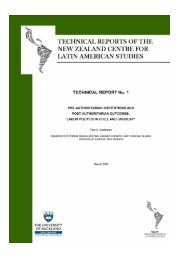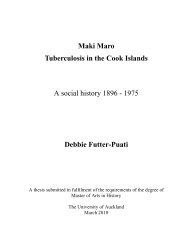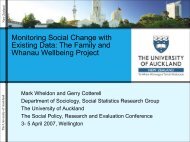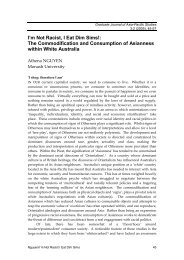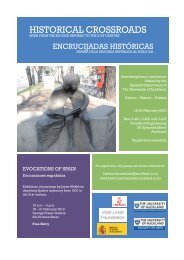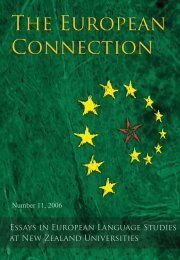Fujitani, Imperialism and Post-World War II Japan
Fujitani, Imperialism and Post-World War II Japan
Fujitani, Imperialism and Post-World War II Japan
- No tags were found...
Create successful ePaper yourself
Turn your PDF publications into a flip-book with our unique Google optimized e-Paper software.
concept <strong>and</strong> a tangible figure was significant in terms of the development of <strong>Japan</strong>esenationalism in the late nineteenth <strong>and</strong> early twentieth century.The significance of the emperor as a symbol of <strong>Japan</strong> remains to some extent in thepostwar years. The emperor system remains intact despite <strong>Japan</strong>’s defeat in the Pacific<strong>War</strong>. While it is true that the survival of the imperial institution was mainly due tooccupation authorities’ fear that chaos would follow should the emperor system beabolished altogether, 47 <strong>and</strong> while the emperor has now been made merely ‘the symbol ofthe state <strong>and</strong> of the unity of the people,’ 48 the significance of the emperor system as aconcept <strong>and</strong> what it meant for contemporary <strong>Japan</strong>ese society cannot be ignored.Firstly, the imperial institution has been important in terms of how contemporary<strong>Japan</strong>ese themselves remember the past. In other words, it has become a significantconcept in public memory. 49 In the 1970s <strong>and</strong> 1980s, Carol Gluck argues, there existedtwo parts to the narrative of the Showa period: one which focused on the early Showayears characterised by militarism <strong>and</strong> war, <strong>and</strong> the other on postwar Showa marked byrecovery, democracy, <strong>and</strong> prosperity. 50 In this sense Showa as a concept has become ayardstick by which the past, the pre-war years, <strong>and</strong> the present, the postwar years, areseparated. Gluck also notes that there have been two interpretations, in the ‘post-Showadiscourse of public memory,’ as to the monarchy’s role in a supposedly democraticnation. 51 The first interpretation views the imperial institution in ‘constitutional terms’,while the second perceives the monarchy as a cultural symbol as well as a symbol ofnational identity. 52Kosaka Masataka’s views illustrate further the importance of the monarchy inpostwar <strong>Japan</strong>. He contends that after the Second <strong>World</strong> <strong>War</strong> both <strong>Japan</strong>ese <strong>and</strong>American officials recognised the need to preserve the imperial institution, <strong>and</strong> thatironically postwar reforms had in effect not only clarified the status of the emperor butalso reinforced the more traditional pre-Meiji imperial institution. 53 Kosaka states:‘The new constitution… far from violating traditional institutions, brought the <strong>Japan</strong>esesystem into a more faithful conformity with tradition…. The U.S. Occupation…ultimately… brought the status of the emperor into line with traditions that went back tothe thirteenth century <strong>and</strong> earlier. Emperors were rarely political…. In ceremony, theygave meaning to the nation.’ 54Kosaka further argues that the fact that the emperor system was retained, that is, thesurvival of the most fundamental historical continuity, is the reason why postwarreforms have been successful. 55 He perceives the modified status of the emperor as arepresentation of the difference pre-war <strong>Japan</strong> <strong>and</strong> postwar <strong>Japan</strong>. 56 On the other h<strong>and</strong>,Herbert P. Bix argues that scholars <strong>and</strong> the media as well contributed to the constructionof Hirohito’s new image as a peace-loving intellectual. 57 In short, the views as such seemto be in line with the notion that the monarchy has been subjected to constantreinvention, especially in times of socio-political changes <strong>and</strong> upheavals, as presented in<strong>Fujitani</strong>’s work.Interestingly, the monarchy as both a symbol <strong>and</strong> a concept continues to be anobject of manipulation in postwar <strong>Japan</strong>. The only difference between the pre-war4 Graduate Journal of Asia-Pacific Studies 1:1 (2003)
extent to the phenomenon of jishuku, for Prime Minister Takeshita Noboru postponedspeaking engagements. 88 Of course there were those who signed the kicho genuinelywishing for the recovery of the emperor, for more than four million signatures had beenobtained. 89The concept of ryosai kenbo is still very much alive in contemporary <strong>Japan</strong>esesociety, <strong>and</strong> the monarchy, as in the pre-war years, serves as an exemplar of this ideal.This is illustrated by the fact that the images of the monarchy had been, <strong>and</strong> still is,constantly crafted to conform to ideals promoted by the state. <strong>Fujitani</strong> argues that thepractice that women in the imperial household, instead of withdrawing into the privatesphere, emerged as public figures in modern <strong>Japan</strong>, had been a construction of the Meijiperiod, in emulation of Western monarchies. 90 Undoubtedly this practice still existstoday, for women of the imperial family are often present in photographs in newspapers<strong>and</strong> magazines. Moreover, that images of the monarchy are constructed is illustrated bythe fact that the Imperial Household Agency was furious about the publication, innewspapers <strong>and</strong> magazines, of an ‘informal’ photograph of newlyweds Prince Akishino<strong>and</strong> Kiko Kawashima in 1990. 91 Barry Hillenbr<strong>and</strong>’s comments, albeit somewhatstereotypical <strong>and</strong> odd, reflects the fact that the imperial family serves as a representationof the ideal of ryosai kenbo:'Despite her troubles, Michiko has been an exemplary mother to her three children <strong>and</strong> aseemingly ideal wife for Akihito, who is devoted to her. During their motor paradethrough the city last week, Emperor <strong>and</strong> Empress carried on a warm <strong>and</strong> animatedconversation, acting more like newlyweds than a couple married for more than 30 years.Michiko is an engaging hostess who speaks fluent English <strong>and</strong> dresses with great flair.' 92Undoubtedly, there still seemed to be a sense of intimacy between the public <strong>and</strong>the imperial family, which has very much been an object of public gaze, as illustrated bythe 1959 wedding of Prince Akihito <strong>and</strong> Michiko Shoda, who was a commoner, whichattracted extensive media coverage. The event was regarded by <strong>Japan</strong>ese youth as arepresentation of the ideal of romantic love <strong>and</strong> Michiko Shoda herself became anaspiration for young females, although there had also been negative views towards thewedding. 93 Interestingly, the marriage between Prince Akishino <strong>and</strong> Kawashima as wellseems to have been hailed as one based on love <strong>and</strong> attracted media attention. 94Nonetheless, the 1959 imperial wedding, along with the kicho, seems to echo the ideathat intimacy between the imperial household <strong>and</strong> the public had been a creation of theMeiji period, as discussed in <strong>Fujitani</strong>’s work. 95 This intimacy may be seen as acontinuity that has been maintained from the Meiji period through to the postwar years.At the same time, however, implied in the reconstruction of the Meiji imperialinstitution were paradoxes <strong>and</strong> ironies, which may be incomprehensible at first glancebut underst<strong>and</strong>able after close examination. Even in the postwar period there areparadoxes resulting from both pre-war <strong>and</strong> postwar reconstructions of the monarchy.Firstly, towards the middle of the Meiji period the intimacy between the monarchy <strong>and</strong>the pubic which was vigorously promoted by the government came to be underminedby the fact that the monarchy had partially withdrawn. 96 Secondly, as <strong>Japan</strong> began toChun/<strong>Fujitani</strong>, <strong>Imperialism</strong> <strong>and</strong> <strong>Post</strong>-<strong>World</strong> <strong>War</strong> <strong>II</strong> <strong>Japan</strong> 7
embark on her mission of empire expansion, the Showa Emperor, who was supposedlya symbol of national unity, actually contributed to disunity within the government dueto his weak character <strong>and</strong> the fact that he, as a constitutional monarch, was unable toh<strong>and</strong> down decisions of his own; 97 <strong>and</strong> yet it has also been argued that at the end of theSecond <strong>World</strong> <strong>War</strong>, ironically, the emperor ‘turned out to be the only viable authoritythat could surrender the huge body of armed forces.’ 98 Moreover, the existence of amonarch in a supposedly <strong>and</strong> practically postwar democratic state is contradiction initself. 99 As Hirohito was dying, although there was extensive media coverage of hishealth condition, the Imperial Household Agency, apparently still embracing theinvented myth that the emperor was divine, was reluctant to say that the emperor wasill. 100 And, lastly, Emperor Akihito himself has in fact not only vowed to protect the newconstitution of <strong>Japan</strong>, <strong>and</strong> is thus silencing right-wing activists’ call for a revision of theconstitution, but also complained about the public’s overreaction to his father’s illness. 101In conclusion, the <strong>Japan</strong>ese monarchy is a relatively recent artefact that wascreated as part of the modernisation process, yet under the guise of tradition, in theMeiji period, <strong>and</strong> has continued to be reinvented in the postwar years, particularly fromthe mid-1970s onwards. It appears that today the monarchy has become more like adiplomat for <strong>Japan</strong>, rather than a ‘manifest deity’. 102 The imperial institution has been asignificant concept <strong>and</strong> a tangible symbol in both the pre-war years <strong>and</strong> the postwaryears, as explained above. In the postwar period there have been various views towardsthe monarchy; these range from outright support to complete apathy <strong>and</strong> even vigorousopposition. 103 At any rate, Emiko’s Ohnuki-Tierney’s analysis of the flexible <strong>Japan</strong>eseconcept of kami, although to some extent different from <strong>Fujitani</strong>’s, 104 may be useful inexplaining why the <strong>Japan</strong>ese monarchy, despite the fact that it had been subjected toconstant reinvention <strong>and</strong> reconstruction by various groups for different purposes, in thepre-war <strong>and</strong> postwar years, still exists today. In addition, a government official’scomment on why the imperial institution still remains intact today perhaps illustratesthe most interesting irony:‘People who are indifferent about the emperor are the ones who really sustain thisinstitution…If there were overwhelming public support for the emperor, then therewould also be intense opposition. With our history, it would be a serious problem ifinterest in the imperial family became too strong.’ 1058 Graduate Journal of Asia-Pacific Studies 1:1 (2003)
NOTES1The specific chapters of <strong>Fujitani</strong>’s work which have been focused on in the writing of this essay are the first<strong>and</strong> fourth chapters. See Takashi <strong>Fujitani</strong>, Splendid Monarchy: Power <strong>and</strong> Pageantry in Modern <strong>Japan</strong>, 1 stpaperback printing, Berkeley, 1998, pp.1-28 <strong>and</strong> 155-194.2ibid., pp.7-10.3Wilbur M. Fridell, ‘Government Ethics Textbooks in Late Meiji <strong>Japan</strong>’, Journal of Asian Studies, 29, 4, 1970,pp.823-833.4<strong>Fujitani</strong>, Splendid Monarchy, pp.11-14 <strong>and</strong> 107.5ibid., p.13.6ibid., pp.12-13.7ibid., pp.20-21.8Stephen S. Large, Emperors of the Rising Sun, Tokyo, 1999, p.30.9Kosaka, Masataka, ‘The Showa Era (1926-1989)’, Daedalus, 119, 3, 1990, pp.27-47.10ibid., p.31.11For details, see <strong>Fujitani</strong>, Splendid Monarchy, p.156.12ibid., p.173.13ibid., pp.173-174. See also Large, Emperors of the Rising Sun, pp.49-51.14For images of the emperor with a militaristic flavour, see, for example, Herbert P. Bix, Hirohito <strong>and</strong> theMaking of Modern <strong>Japan</strong>, New York, 2000, pp.248-255, Marius B. Jansen, The Making of Modern <strong>Japan</strong>,Cambridge, 2000, pp.589-593, <strong>and</strong> Large, Emperors of the Rising Sun, pp.122-126.15Large, Emperors of the Rising Sun, p.155.16ibid.17Shunsuke Tsurumi, An Intellectual History of <strong>War</strong>time <strong>Japan</strong>, Reprinted edn, London, 1986, p.25.18Large, Emperors of the Rising Sun, p.48.19<strong>Fujitani</strong>, Splendid Monarchy, pp.176-177.20ibid., p.183.21ibid., p.180.22Kathleen S. Uno, “The Death of ‘Good Wife, Wise Mother’?”, in Andrew Gordon, ed, <strong>Post</strong>war <strong>Japan</strong> asHistory, Berkeley, 1993, pp.293-322.23ibid. For a detailed analysis of <strong>Japan</strong>ese attitudes towards marriage <strong>and</strong> divorce in different periods, seeFumie Kumagai, ‘Changing Divorce in <strong>Japan</strong>’, Journal of Family History, 8, 1983, pp.85-108.24Large, Empire of the Rising Sun, p.31.25W.G. Beasley, The Rise of Modern <strong>Japan</strong>: Political, Economic, <strong>and</strong> Social Change since 1850, 3 rd edn, London,2000, pp.185-186.26ibid., p.186.27Stefan Tanaka, <strong>Japan</strong>’s Orient: Rendering Pasts into History, 1 st paperback printing, Berkeley, 1995, p.133.28Beasley, The Rise of Modern <strong>Japan</strong>, p.166.29Mikiso Hane, Modern <strong>Japan</strong>: A Historical Survey, 2 nd edn, Boulder, 1992, p.259.30ibid, pp.237-238. Between 1927 <strong>and</strong> 1929 General Tanaka Giichi, as Prime Minister of <strong>Japan</strong>, adopted anaggressive policy towards China. It was during this period that militarism began to emerge.31ibid., p.259.32Large, Emperors of the Rising Sun, p.156.33For instance, Minobe Tatsukichi’s ‘organ theory’ (tenno kikan setsu) which viewed the emperor as merelyan ‘organ’ of the state, not an absolute manifest deity representing imperial <strong>Japan</strong>, was rejected by the mid-1930s. On the other h<strong>and</strong>, Uesugi Shinkichi argued that sovereignty rested with the emperor. See Large,Emperors of the Rising Sun, pp.155-156, <strong>and</strong> Peter Duus, ‘Socialism, Liberalism, <strong>and</strong> Marxism, 1901-1931,’ inPeter Duus, ed, The Cambridge History of <strong>Japan</strong>, Volume 6, The Twentieth Century, reprinted edn, Cambridge,1997, pp.654-710.34John W. Dower, <strong>War</strong> without Mercy: Race <strong>and</strong> Power in the Pacific <strong>War</strong>, New York, 1986, pp.221-222.35Tsurumi, An Intellectual History of <strong>War</strong>time <strong>Japan</strong>, p.27.36ibid.Chun/<strong>Fujitani</strong>, <strong>Imperialism</strong> <strong>and</strong> <strong>Post</strong>-<strong>World</strong> <strong>War</strong> <strong>II</strong> <strong>Japan</strong> 9
37Large, Emperors of the Rising Sun, p.114. See also Stephen S. Large, ‘Emperor Hirohito <strong>and</strong> Early Showa<strong>Japan</strong>’, in Stephen S. Large, ed, Showa <strong>Japan</strong>: Political, Economic <strong>and</strong> Social History 1926-1989, London, 1998,pp.239-258, <strong>and</strong> Tokyo Correspondent, ‘<strong>Japan</strong>’s $80m Imperial Banzai’, The Economist, 317, 7680, 1990, p.31.38For details, see Masataka Kosaka, ‘The Showa Era (1926-1989)’, Daedalus, 119, 3, 1990, pp.27-47.39Wilbur M. Fridell, ‘Government Ethics Textbooks in Late Meiji <strong>Japan</strong>’, Journal of Asian Studies, 29, 4, 1970,pp.823-833.40Wataru Kurita, ‘Making Peace with Hirohito <strong>and</strong> a Militaristic Past’, <strong>Japan</strong> Quarterly, 36, 2, 1989, pp.186-192.41ibid.42ibid.43Kigensetsu was the national festival day on which the accession to the throne of Jimmu, the first emperor,was commemorated. See Large, Emperors of the Rising Sun, p.30.44ibid.45Tsurumi, An Intellectual History of <strong>War</strong>time <strong>Japan</strong>, p.27.46Charles Nelson Spinks, ‘Indoctrination <strong>and</strong> Re-education of <strong>Japan</strong>’s Youth’, Pacific Affairs, 17, 1, 1944,pp.56-70.47In fact, General Douglas MacArthur believed that it was desirable that the emperor system be retained forthe sake of a smooth occupation, <strong>and</strong> thus to avoid the need for a larger occupation force for a longer periodof time. Moreover, the Supreme Comm<strong>and</strong>er of the Allied Powers (SCAP) <strong>and</strong> American officials intendedto utilise the existing form of <strong>Japan</strong>ese government to their advantage. This is evident in Philip R.Piccigallo’s observations: “United States occupation policy intended to ‘use the existing form of governmentin <strong>Japan</strong>,’ albeit not supporting it. That is, <strong>Japan</strong>ese government was to serve as ‘executor’ of Americanpolicy.” See Philip R. Piccigallo, The <strong>Japan</strong>ese on Trial: Allied <strong>War</strong> Crimes Operations in the East 1945-1951,Austin, 1979, pp.16-17.48Harold S. Quigley <strong>and</strong> John E. Turner, The New <strong>Japan</strong>: Government <strong>and</strong> Politics, Minneapolis, 1956, p.169.49Carol Gluck, ‘The Idea of Showa’, Daedalus, 119, 3, 1990, pp.1-26.50ibid.51ibid.52ibid.53Masataka Kosaka, ‘The Showa Era (1926-1989)’, Daedalus, 119, 3, 1990, pp.27-47.54ibid. (emphasis added)55ibid.56ibid.57For details, see Herbert P. Bix, “Inventing the ‘Symbol Monarchy’ in <strong>Japan</strong>, 1945-1952”, Journal of <strong>Japan</strong>eseStudies, 21, 2, 1995, pp.319-363.58John W. Dower’s comments on the implications of the new image <strong>and</strong> status of the Showa emperor isquite interesting. He argues that the abrupt change of Hirohito’s appearance, from his image as ageneralissimo to that as a ‘human’ emperor among the general populace, represents not only national unitybut also ‘retrospective disunity’, as the militarists ‘who had just yesterday acted in his name abruptlybecame today’s scapegoats <strong>and</strong> demonic forces.’ And, ironically, the kokutai <strong>and</strong> the monarchy surviveddespite <strong>Japan</strong>’s defeat in the Pacific <strong>War</strong> <strong>and</strong> the American occupation. See John W. Dower, <strong>War</strong> WithoutMercy, pp.307-308.59Yoshio Sugimoto, An Introduction to <strong>Japan</strong>ese Society, reprinted edn, Cambridge, 2000, p.216.60ibid.61ibid.62ibid.63Peter Duus, ‘Socialism, Liberalism, <strong>and</strong> Marxism, 1901-1931,’ in Peter Duus, ed, The Cambridge History of<strong>Japan</strong>, Volume 6, The Twentieth Century, reprinted edn, Cambridge, 1997, pp.654-710.\64Large, Emperors of the Rising Sun, p.195.65ibid.66ibid.67ibid., p.197.10 Graduate Journal of Asia-Pacific Studies 1:1 (2003)
68Osamu Watanabe, ‘The Sociology of Jishuku <strong>and</strong> Kicho: the Death of Showa Tenno as a Reflection of theStructure of Contemporary <strong>Japan</strong>ese Society’, in Edward R. Beauchamp, Dimensions of Contemporary <strong>Japan</strong>: ACollection of Essays, New York, 1998, pp.305-319.69ibid., pp.197-198.70Yugo Suzuki, ‘Hirohito <strong>and</strong> the Fate of the Emperor System’, The Christian Century, 106, 1, January 4-11,1989, pp.5-7.71Charles Smith, ‘Doubts <strong>and</strong> Boycotts Usher in a New Era of Peace: At the Crossroads’, Far EasternEconomic Review, 143, 3, January 19, 1989, pp.10-11. Smith also notes that Nakasone’s attempt to ‘attributethoughts to Hirohito’ signified a return to the pre-war practice where political leaders claimed imperialsanction for their own decisions.72Michael Doan, ‘<strong>Japan</strong>ese Royal Family: Anchor to an Ancient Past’, U.S. News <strong>and</strong> <strong>World</strong> Report, 100, May12, 1986, p.13.73Tokyo Correspondent, ‘<strong>Japan</strong>’s $80m Imperial Banzai’, The Economist, 317, 7680, 1990, p.31.74Large, Emperors of the Rising Sun, p.196.75ibid., p.198.76ibid., pp.195-196. It should be noted that in the postwar years prime ministers before Nakasone had in factmade unofficial visits to the shrine on August 15 every year. Nakasone was the first prime minister to visitthe shrine officially.77ibid.78Kantaro Awaya, ‘Emperor Showa’s Accountability for <strong>War</strong>’, <strong>Japan</strong> Quarterly, 38, 4, 1991, pp.386-398.79Wataru Kurita, ‘Making Peace with Hirohito <strong>and</strong> a Militaristic Past’, <strong>Japan</strong> Quarterly, 36, 2, 1989, pp.186-192.80Osamu Watanabe, ‘The Sociology of Jishuku <strong>and</strong> Kicho: the Death of Showa Tenno as a Reflection of theStructure of Contemporary <strong>Japan</strong>ese Society’, in Edward R. Beauchamp, Dimensions of Contemporary <strong>Japan</strong>: ACollection of Essays, New York, 1998, pp.305-319.81ibid.82ibid.83ibid.84ibid.85ibid.86ibid.87ibid.88Takashi <strong>Fujitani</strong>, “Electronic Pageantry <strong>and</strong> <strong>Japan</strong>’s ‘Symbolic Emperor’”, Journal of Asian Studies, 51, 4,1994, pp.824-850.89Yugo Suzuki, ‘Hirohito <strong>and</strong> the Fate of the Emperor System’, The Christian Century, 106, 1, January 4-11,1989, pp.5-7.90<strong>Fujitani</strong>, Splendid Monarchy, p.183.91Kumiko Makihara, ‘Guarding the Chrysanthemum Curtain’, Time, 136, 48, November 26, 1990, p.15.92Barry, Hillenbr<strong>and</strong>, ‘Ascending the Throne’, Time, November 26, 1990, 136, 48, pp.12-15.93Jayson Chun, ‘A New Kind of Royalty: The Imperial Family <strong>and</strong> the Media in <strong>Post</strong>war <strong>Japan</strong>’, in TimothyJ. Craig, <strong>Japan</strong> Pop!: Inside the <strong>World</strong> of <strong>Japan</strong>ese Popular Culture, New York, 2000, pp.222-243.94For details, see People Weekly, ‘The Emperor’s Second Son Falls in Love with a Commoner—<strong>and</strong> so doesthe Rest of <strong>Japan</strong>’, People Weekly, Sept 18, 1989, 32, 12, pp.54-55.95<strong>Fujitani</strong>, Splendid Monarchy, p.163.96Masao Maruyama, ‘Thought <strong>and</strong> Behaviour Patterns of <strong>Japan</strong>’s <strong>War</strong>time Leaders’, in Ivan Morris, ed,Thought <strong>and</strong> Behaviour in Modern <strong>Japan</strong>ese Politics, London, 1963, pp.84-134.97Marius B. Jansen, ‘The Presidential Address: Monarchy <strong>and</strong> Modernisation in <strong>Japan</strong>’, Journal of AsianStudies, 36, 4, pp.611-622.98J.M. Kitagawa, ‘Some Reflections on <strong>Japan</strong>ese Religion <strong>and</strong> Its Relationship to the Imperial System’,<strong>Japan</strong>ese Journal of Religious Studies, 17, 2-3, pp.129-178, quoted in Emiko Ohnuki-Tierney, ‘The Emperor of<strong>Japan</strong> as Deity (Kami)’, Ethnology, 30, 3, 1991, pp.199-215.Chun/<strong>Fujitani</strong>, <strong>Imperialism</strong> <strong>and</strong> <strong>Post</strong>-<strong>World</strong> <strong>War</strong> <strong>II</strong> <strong>Japan</strong> 11
99Yugo Suzuki, ‘Hirohito <strong>and</strong> the Fate of the Emperor System’, The Christian Century, 106, 1, January 4-11,1989, pp.5-7.100Brian Moeran, ‘Last Days of the Emperor’, Encounter, 72, 2, 1989, pp.58-62.101Charles Smith, ‘Doubts <strong>and</strong> Boycotts Usher in a New Era of Peace: At the Crossroads’, Far EasternEconomic Review, 143, 3, January 19, 1989, pp.10-11.102Michael Vatikiotis, ‘Deity to Diplomat: Erstwhile Conqueror searches for a New Regional Role’, FarEastern Economic Review, 154, 40, October 3, 1991, p.38.103See Emiko Ohnuki-Tierney, ‘The Emperor of <strong>Japan</strong> as Deity (Kami)’, Ethnology, 30, 3, 1991, pp.199-215,Tokyo Correspondent, ‘<strong>Japan</strong>’s $80m Imperial Banzai’, The Economist, 317, 7680, 1990, p.31, <strong>and</strong> WataruKurita, ‘Enthroning a New Emperor’, <strong>Japan</strong> Quarterly, 38, 1, 1991, pp.42-49.104Ohnuki-Tierney argues that for a long time the kami have been regarded as both human <strong>and</strong> deity by the<strong>Japan</strong>ese people, <strong>and</strong> that historical actors like the military were merely assigning meanings to it ‘like anempty vessel.’ See Emiko Ohnuki-Tierney, ‘The Emperor of <strong>Japan</strong> as Deity (Kami)’, Ethnology, 30, 3, 1991,pp.199-215.105Robert Delfs, ‘Emperor’s Minders: <strong>Japan</strong>ese Agency Keeps Public at a Distance’, Far Eastern EconomicReview, 156, 17, April 29, 1993, pp.21-22.12 Graduate Journal of Asia-Pacific Studies 1:1 (2003)




